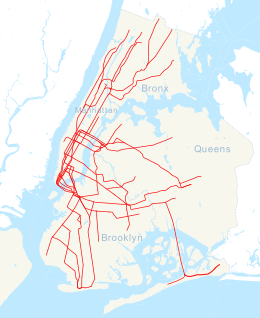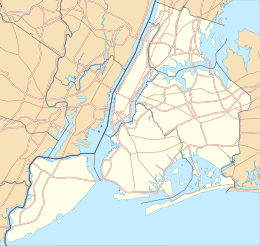railroad.wikisort.org - Station
The Freeman Street station is a local station on the IRT White Plains Road Line of the New York City Subway. Located at the intersection of Freeman Street and Southern Boulevard in the Bronx, it is served by the 2 train at all times, and the 5 train at all times except late nights and rush hours in the peak direction.
Freeman Street | ||||||||||||||||||||||||||||||||||||||||||||||||||||||||||||||||||||
|---|---|---|---|---|---|---|---|---|---|---|---|---|---|---|---|---|---|---|---|---|---|---|---|---|---|---|---|---|---|---|---|---|---|---|---|---|---|---|---|---|---|---|---|---|---|---|---|---|---|---|---|---|---|---|---|---|---|---|---|---|---|---|---|---|---|---|---|---|
 Northbound platform | ||||||||||||||||||||||||||||||||||||||||||||||||||||||||||||||||||||
| Station statistics | ||||||||||||||||||||||||||||||||||||||||||||||||||||||||||||||||||||
| Address | Freeman Street & Southern Boulevard Bronx, NY 10459 | |||||||||||||||||||||||||||||||||||||||||||||||||||||||||||||||||||
| Borough | The Bronx | |||||||||||||||||||||||||||||||||||||||||||||||||||||||||||||||||||
| Locale | Crotona Park East | |||||||||||||||||||||||||||||||||||||||||||||||||||||||||||||||||||
| Coordinates | 40.83°N 73.892°W | |||||||||||||||||||||||||||||||||||||||||||||||||||||||||||||||||||
| Division | A (IRT)[1] | |||||||||||||||||||||||||||||||||||||||||||||||||||||||||||||||||||
| Line | IRT White Plains Road Line | |||||||||||||||||||||||||||||||||||||||||||||||||||||||||||||||||||
| Services | 2 5 | |||||||||||||||||||||||||||||||||||||||||||||||||||||||||||||||||||
| Transit | ||||||||||||||||||||||||||||||||||||||||||||||||||||||||||||||||||||
| Structure | Elevated | |||||||||||||||||||||||||||||||||||||||||||||||||||||||||||||||||||
| Platforms | 2 side platforms | |||||||||||||||||||||||||||||||||||||||||||||||||||||||||||||||||||
| Tracks | 3 | |||||||||||||||||||||||||||||||||||||||||||||||||||||||||||||||||||
| Other information | ||||||||||||||||||||||||||||||||||||||||||||||||||||||||||||||||||||
| Opened | November 26, 1904 (3rd Ave. Line; Bergen Avenue By-pass) July 10, 1905 (White Plains Rd. Line) | |||||||||||||||||||||||||||||||||||||||||||||||||||||||||||||||||||
| Opposite- direction transfer | No | |||||||||||||||||||||||||||||||||||||||||||||||||||||||||||||||||||
| Traffic | ||||||||||||||||||||||||||||||||||||||||||||||||||||||||||||||||||||
| 2019 | 1,358,821[2] | |||||||||||||||||||||||||||||||||||||||||||||||||||||||||||||||||||
| Rank | 316 out of 424[2] | |||||||||||||||||||||||||||||||||||||||||||||||||||||||||||||||||||
| ||||||||||||||||||||||||||||||||||||||||||||||||||||||||||||||||||||
| ||||||||||||||||||||||||||||||||||||||||||||||||||||||||||||||||||||
| ||||||||||||||||||||||||||||||||||||||||||||||||||||||||||||||||||||
| ||||||||||||||||||||||||||||||||||||||||||||||||||||||||||||||||||||
| ||||||||||||||||||||||||||||||||||||||||||||||||||||||||||||||||||||
History
Early history
The first contract for the construction of a subway in New York, Contract 1, was executed on February 21, 1900, between the Board of Rapid Transit Railroad Commissioners and the Rapid Transit Construction Company, organized by John B. McDonald and funded by August Belmont, for the construction of the subway and a 50-year operating lease from the opening of the line. Contract 1 called for the construction of a line from City Hall north to Kingsbridge and a branch under Lenox Avenue and to Bronx Park.[3] The initial segment of the IRT White Plains Road Line opened on November 26, 1904 between 180th Street–Bronx Park and Jackson Avenue. Initially, trains on the line were served by elevated trains from the IRT Second Avenue Line and the IRT Third Avenue Line. Once the connection to the IRT Lenox Avenue Line opened on July 10, 1905, trains from the newly opened IRT subway ran via the line.[4][5][6]
To address overcrowding, in 1909, the New York Public Service Commission proposed lengthening platforms at stations along the original IRT subway.[7]: 168 As part of a modification to the IRT's construction contracts, made on January 18, 1910, the company was to lengthen station platforms to accommodate ten-car express and six-car local trains. In addition to $1.5 million (equivalent to $43.6 million in 2021) spent on platform lengthening, $500,000 (equivalent to $14,541,071 in 2021) was spent on building additional entrances and exits. It was anticipated that these improvements would increase capacity by 25 percent.[8]: 15 The northbound platform at the Freeman Street station was extended 50 feet (15 m) to the front and 40 feet (12 m) to the rear,[8]: 114 while the southbound platform was not lengthened.[8]: 106 On January 23, 1911, ten-car express trains began running on the White Plains Road Line.[7]: 168 [9]
Station renovations
In Fiscal Year 1915, an additional stairway was being added to the station.[10]
The city government took over the IRT's operations on June 12, 1940.[11][12] The New York State Transit Commission announced plans to extend the southbound platforms at seven stations on the line from Jackson Avenue to 177th Street to accommodate ten-car trains for $81,900 on August 8, 1934. The platform at Freeman Street would be lengthened from 350 feet (110 m) to 505 feet (154 m).[13]
Up until 1946, a limited number of rush-hour northbound trains on the Second and Third Avenue Lines terminated at this station, relaying north of it to turn around for southbound service.[14]: 121 The Bergen Avenue cutoff, which allowed Third Avenue trains to access the White Plains Road Line, was abandoned on November 5, 1946, as part of the gradual curtailment of elevated service on the IRT Third Avenue Line.[5] On June 13, 1949, the platform extensions at this station, as well as those on White Plains Road Line stations between Jackson Avenue and 177th Street, opened. The platforms were lengthened to 514 feet (157 m) to allow full ten-car express trains to open their doors. Previously, the stations could only platform six-car local trains.[15]
The station was renovated in 2004.[citation needed] The interlocking north of the station and the tower controlling it were both removed in March 2004 when the line was re-signaled to B Division specifications.[14]: 3
Station layout
| P Platform level |
Side platform | |
| Northbound local | ← ← | |
| Peak-direction express | ← ← | |
| Southbound local | | |
| Side platform | ||
| G | Street level | Exit/entrance |

This elevated station has three tracks and two side platforms.[16] The center express track is used by the 5 train during rush hours in the peak direction.[17]
As with other original IRT elevated viaducts, the elevated structure at Freeman Street is carried on two column bents, one on each side of the road, at places where the tracks are no more than 29 feet (8.8 m) above the ground level. There is zigzag lateral bracing at intervals of every four panels.[18]
The 2007 artwork at this station, The El, was designed by the artist Daniel Hauben and commissioned through the MTA Arts & Design program. It consists of four faceted-glass windbreaks and two niche windows, depicting the roadway and the elevated tracks above, which recede in the background.[19][20] According to the artist, the artwork is designed to convey a "feeling of both great depth and the sprawling vastness of the city".[20]
Exits
The station has heaters, as well as a wooden mezzanine, floor, and open old booth similar to the one at Simpson Street. Exits lead to all corners of Freeman Street and Southern Boulevard.[21]
References
- "Glossary". Second Avenue Subway Supplemental Draft Environmental Impact Statement (SDEIS) (PDF). Vol. 1. Metropolitan Transportation Authority. March 4, 2003. pp. 1–2. Archived from the original (PDF) on February 26, 2021. Retrieved January 1, 2021.
- "Facts and Figures: Annual Subway Ridership 2014–2019". Metropolitan Transportation Authority. 2020. Retrieved May 26, 2020.
- Walker, James Blaine (1918). Fifty Years of Rapid Transit, 1864-1917. New York City: The Law Printing Company. pp. 139–161. OCLC 03638541.
- "Discuss Subway Signs in 18th St. Station" (PDF). The New York Times. November 27, 1904. ISSN 0362-4331. Archived (PDF) from the original on March 24, 2020.
- Kahn, Alan Paul (January 1, 1973). Tracks of New York /. New York : Electric Railroaders' Association.
- "Subway Trains Running From Bronx to Battery" (PDF). The New York Times. July 10, 1905. ISSN 0362-4331. Archived (PDF) from the original on March 24, 2020. Retrieved September 4, 2016.
- Hood, Clifton (1978). "The Impact of the IRT in New York City" (PDF). Historic American Engineering Record. pp. 146–207 (PDF pp. 147–208). Archived (PDF) from the original on January 17, 2021. Retrieved December 20, 2020.
 This article incorporates text from this source, which is in the public domain.
This article incorporates text from this source, which is in the public domain.{{cite web}}: CS1 maint: postscript (link) - Report of the Public Service Commission for the First District of the State of New York For The Year Ending December 31, 1910. Public Service Commission. 1911. Archived from the original on January 20, 2021. Retrieved January 7, 2021.
- "Ten-car Trains in Subway to-day; New Service Begins on Lenox Av. Line and Will Be Extended to Broadway To-morrow". The New York Times. January 23, 1911. ISSN 0362-4331. Archived from the original on April 5, 2018. Retrieved April 5, 2018.
- 1914-1915 Annual Report of the Interborough Rapid Transit Company for the Year Ended June 30, 1915. Interborough Rapid Transit Company. 1915. p. 14. Archived from the original on May 4, 2022. Retrieved December 22, 2020.
- "City Transit Unity Is Now a Reality; Title to I.R.T. Lines Passes to Municipality, Ending 19-Year Campaign". The New York Times. June 13, 1940. ISSN 0362-4331. Archived from the original on January 7, 2022. Retrieved May 14, 2022.
- "Transit Unification Completed As City Takes Over I. R. T. Lines: Systems Come Under Single Control After Efforts Begun in 1921; Mayor Is Jubilant at City Hall Ceremony Recalling 1904 Celebration". New York Herald Tribune. June 13, 1940. p. 25. ProQuest 1248134780.
- "I.R.T. To Extend Stations. Platform Changes to Be Made on White Plains Line". The New York Times. August 9, 1934. ISSN 0362-4331. Archived from the original on January 8, 2021. Retrieved January 4, 2020.
- Dougherty, Peter (2020). Tracks of the New York City Subway 2020 (16th ed.). Dougherty. OCLC 1056711733.
- Report for the three and one-half years ending June 30, 1949. New York City Board of Transportation. 1949. hdl:2027/mdp.39015023094926.
- Dougherty, Peter (2006) [2002]. Tracks of the New York City Subway 2006 (3rd ed.). Dougherty. OCLC 49777633 – via Google Books.
- "5 Subway Timetable, Effective June 26, 2022". Metropolitan Transportation Authority. Retrieved August 1, 2022.
- Transit Journal. 1904. p. 470. Archived from the original on May 24, 2022. Retrieved April 16, 2020.
 This article incorporates text from this source, which is in the public domain..
This article incorporates text from this source, which is in the public domain..{{cite book}}: CS1 maint: postscript (link) - "Freeman Street and Southern Boulevard; Daniel Hauben". Lehman College. Archived from the original on March 27, 2016. Retrieved March 28, 2021.
- "Freeman Street - Daniel Hauben - The El, 2007". web.mta.info. Metropolitan Transportation Authority. Archived from the original on August 8, 2020. Retrieved December 24, 2020.
- "Freeman Street Neighborhood Map" (PDF). new.mta.info. Metropolitan Transportation Authority. April 2018. Archived (PDF) from the original on July 3, 2018. Retrieved February 28, 2019.
External links
- nycsubway.org – IRT White Plains Road Line: Freeman Street
На других языках
- [en] Freeman Street station
[ru] Фримен-стрит (линия Уайт-Плейнс-роуд, Ай-ар-ти)
«Фримен-стрит» (англ. Freeman Street) — станция Нью-Йоркского метрополитена, расположенная на линии Уайт-Плейнс-роуд, Ай-ар-ти. На станции останавливаются маршруты 2 (круглосуточно) и 5 (круглосуточно, кроме часов пик в пиковом направлении и ночи). Станцию проходит без остановки маршрут 5 (в часы пик в пиковом направлении). Станция представлена двумя боковыми платформами, обслуживающими два пути.Другой контент может иметь иную лицензию. Перед использованием материалов сайта WikiSort.org внимательно изучите правила лицензирования конкретных элементов наполнения сайта.
WikiSort.org - проект по пересортировке и дополнению контента Википедии



